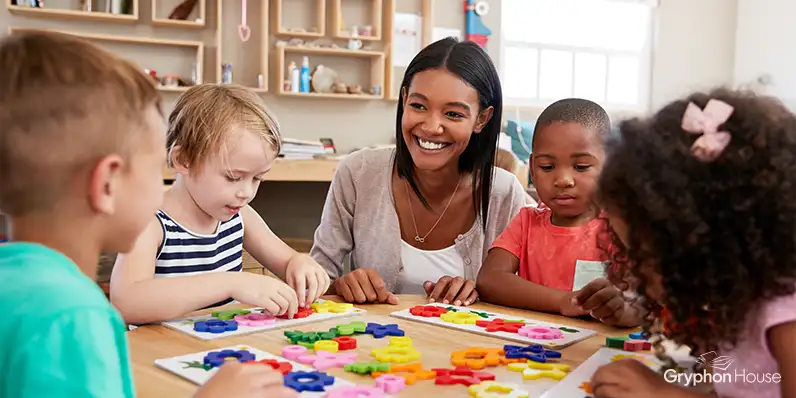3 Essential Skills for Kids to Take on the School Year
August 14th, 2014 | 3 min. read

It’s easy to focus on preparing kids academically for the upcoming school year, but it can be hard to remember that students also need to be socially prepared. Along with financial literacy, phonics, and science exploration, children need to understand the importance of resilience, self-control, and intentionality. To get kids started, here are three fundamental building blocks for future learning and how you can teach them.
1. Cooperation
Gryphon House author Pam Schiller defines it as a willingness and ability to work with others. Cooperativeness is an important skill for students to possess when entering into what can be a chaotic first week of school. Understanding how to work toward common goals will allow children to be a part of bringing order to the classroom. Children will be able to complete tasks faster and understand how to use advice from others to reach combined solutions. Putting two minds together will get work finished a lot faster than being stumped and unwilling to ask for help. It will also go a long way in helping students to make new friends and bond in the shared experience of starting a new school year.
Ways to Inspire Cooperativeness
- Modeling: The most important way you can call attention to this fundamental skill is by modeling it in yourself, whether at home or in the classroom. Help others out, ask for advice, and integrate yourself into a child’s play by using interaction to complete tasks. Children will notice what you are doing and begin to mimic it, as well.
- Talk About It: Explain to children the meaning of cooperation and why it is important. Read books that model the behavior and point out cooperation that is occurring around children, whether it is combined efforts to clean a classroom or a combined family effort to make dinner.
- Activity: Tug of Peace: Take hula hoops outdoors and encourage children to play the Tug of Peace game. It takes cooperative effort. Children sit around the hula hoop and grab hold with both hands. By pulling back on the hoop, can everyone stand up together?
2. Intentionality
Gryphon House author Pam Schiller defines intentionality as acting with intention on a course of action or an aim that one intends to follow; a plan to achieve; setting a goal. Intentionality will allow children to not only set appropriate goals but also find ways to achieve them during the school year. With confidence in choices, children will be more likely to achieve their goals.
Ways to Teach Intentionality:
- Modeling: Sharing intentionality in your life is important in the process of teaching the trait to children. You can put intentionality on display by talking to children about choices you make every day and why you made those choices. If a child asks why, be sure your answer is thought out and then explain your answer and thought process.
- Talk About It: Discuss the importance of accomplishments and how children can go about achieving their goals. Be sure you talk about the difference between doing what is wanted and doing what is right and between a “need” and a “want.”
- Activity: Set a challenge. Children need to be stimulated when working toward goals. Have children set goals that are slightly out of their comfort zone. Have them keep up with their progress daily. Once they’ve achieved what they set out to, children will have developed an internal sense of satisfaction from knowing they followed through with what was intended.
3. Relating to Others
Gryphon House author Pam Schiller defines relating to others as the act of being connected, related. Becoming socially adept is a huge part of the learning process as children enter into a room of peers their own age. Being able to properly read and respond to social cues is something that will be taken far beyond the classroom.
Ways to Teach Relating to Others:
- Modeling: Pay attention to children’s facial expressions or body language so that they see you responding to social cues. Say something like, “I could tell by your eyes that it surprised you when Joseph handed you the ball.” Also, be sure to verbally express what you are feeling when appropriate. It will show children that expressing emotion is natural.
- Talk About It: Asking open-ended questions after reading time is a great way to get children to relate to the characters in the book. They can associate their feelings with those of the character. It’s also important to encourage children to talk about their feelings with friends and listen intently when they are being confided in.
- Activity: Play Elbow Cut-Ins with a group of children. Select a child to be IT. Have each of the remaining children find a partner. Instruct partners to hook elbows. Count to three as a signal for partners to start running. IT catches up with one of the pairs and hooks elbows with one of the two children. The other child becomes the new IT. She must join herself to another pair.
Want to learn more of the fundamental blocks for future learning in students? Check out Pam Schiller’s Seven Skills for School Success to discover all the skills children need for a successful school year. For even more social and emotional resources, check out Socially Strong, Emotionally Secure.
Author(s)Karen Cairone, Nefertiti Bruce, Pam Schiller
A graduate of Western Carolina University with a BA in English, Brianna served as a marketing and editorial Intern with Gryphn House in the Summer 2018.
Topics: